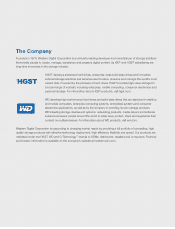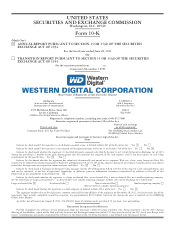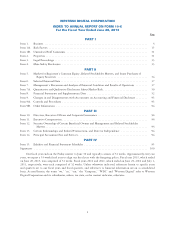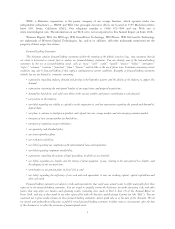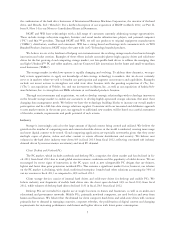Western Digital 2013 Annual Report Download - page 12
Download and view the complete annual report
Please find page 12 of the 2013 Western Digital annual report below. You can navigate through the pages in the report by either clicking on the pages listed below, or by using the keyword search tool below to find specific information within the annual report.Mobile hard drives for notebook PCs, the industry’s highest volume market, have traditionally been in a 2.5-inch
form factor with a 9.5 mm height. We believe we have led a trend toward thinner, lighter devices with extended bat-
tery life and low power consumption, first with our family of 7 mm height drives and more recently with our 5 mm
height drives in both traditional hard drive and hybrid drive configurations. A solid-state hybrid drive is a form of a
hard drive that incorporates NAND flash technology in the caching function. Solid-state hybrid drives specifically
designed for mobile computing combine the power and performance of solid-state drives with the capacity, afford-
ability and availability attributes of hard drives.
Enterprise
We believe shipments into the enterprise market of the storage industry remained relatively flat in fiscal 2013
from fiscal 2012. Enterprise storage devices consist of performance and capacity hard drives, as well as enterprise class
solid-state drives. All of these devices are used in multiple types of enterprise datacenters that provide storage for a
range of cloud and corporate applications. Within datacenters, these drives are typically used in servers and storage
systems.
Performance applications are essential to the operations of an enterprise and require the greatest capabilities and
reliability in hard drives and solid-state drives. This class of drives is the most highly engineered product line in the
storage industry. The infrastructure to support cloud computing storage is driving the demand for multi-platter high
capacity hard drives and enterprise class solid-state drives in tiered architectures. Cloud computing delivers shared
resources, software and information to users on demand on a multitude of devices, such as client PCs, tablets and
smart phones. Most cloud computing models consist of services delivered through large datacenters with enterprise-
class servers, utilizing tiered architectures to address multiple levels of storage needs. We believe we have established a
leading position in supplying advanced multi-platter high capacity drives and solid-state drives with Serial Attached
SCSI (Small Computer System Interface) (“SAS”) to address these needs.
We believe that capacity hard drives, performance hard drives and solid-state drives represented 49%, 46% and
5% of the industry unit shipments into enterprise systems in fiscal 2013, respectively.
Branded Products
External storage devices supplement the storage space of PC systems for home and small office networks and,
through wireless connections, provide remote access to personal content. The highest volume products include direct-
attached and network-attached external drives. They are ideally suited to back up data on internal drives because of
their portability and security features. We believe hard drive shipments into the external storage market increased
42% in fiscal 2013 from fiscal 2012. Branded products also include media players that connect to a user’s television or
home theater system and play digital movies, music and photos from an integrated hard drive, Universal Serial Bus
(“USB”) mass storage device or content services accessed over the Internet.
Consumer Electronics
Hard drives for CE products are primarily used in digital video recorders (“DVRs”), game consoles and security
video recording systems. We believe hard drive unit shipments into the CE market declined 22% in fiscal 2013 from
fiscal 2012.
DVRs offer greater consumer viewing flexibility and enhanced capabilities such as pausing live television, sim-
plifying the process of recording and cataloging recorded television programs and quickly forwarding or returning to
any section of a recorded television program. Game consoles enable users to save games, movies, music, pictures and
other user generated content. We believe growth in the CE market will continue to create demand for higher capacity
hard drives.
Competition
We compete with manufacturers of hard drives for client compute, client non-compute and enterprise applica-
tions and manufacturers of solid-state drives. Competition in the hard drive market consists of five principal brands:
HGST, Samsung, Seagate, Toshiba and WD. In solid-state products we compete with a wide range of manufacturers,
6


